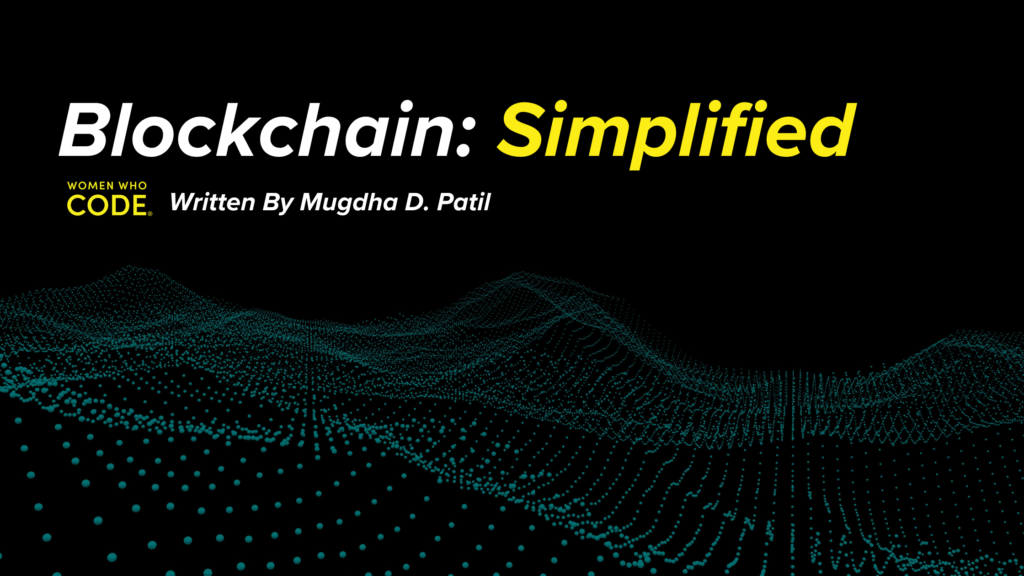BLOCKCHAIN: SIMPLIFIED
Written by WWC Team

By: Mugdha D. Patil
Imagine a scenario where you’ve just earned a rare and valuable stone in your favorite video game, and now you have the opportunity to trade it outside the confines of the game itself. Sounds exciting, doesn’t it? Well, this is just one of the countless applications of blockchain technology.
Now, let’s delve into the essence of blockchain!
Picture three friends—Tom, Alice, and Bob—enjoying a day out together. They play on the turf, have a delightful dinner at a restaurant, and then book a cab to return home. When it comes time to settle the bills, confusion arises. Who owes whom, and how much? Sensibly, they decide to keep a ledger to track their expenses.
1. Decentralized Ledger: The Foundation of Trust
A record of every penny spent and the name of the friend who paid it: that’s what blockchain is—a Ledger.
But this ledger is “Decentralised.”
Each person—Alice, Bob, and Tom—has a copy of the ledger, and there is no central authority overseeing the transactions. Contrast this with traditional banking, where intermediaries(banks) facilitate money transfers between individuals.
With blockchain’s peer-to-peer (P2P) nature, money and information flow directly between friends, which fosters Transparency, ensuring that both parties actively participate in the transaction.
2. Distributed and Tamperproof: Safeguarding the Truth
How can we prevent Bob from adding his own line to the ledger?
The solution lies in the Distributed nature of the ledger. Each friend possesses a copy of the ledger, making it impossible for Tom to tamper with it without alerting Alice and Bob. If Tom adds an unauthorized entry, it won’t match the ledgers of Alice and Bob, immediately exposing the falsehood.
Hence, Tamperproof in nature. Any attempt to tamper with the ledger is swiftly identified and invalidated by ensuring consensus among all participants.
3. Trust: The Digital Signature
But what if someone outside the group, like Mary, adds a false entry to the ledger claiming that Bob owes Tom $100? How can we trust any given entry? To prevent this, the friends decide to sign each line.
Similarly, in blockchain, every transaction is accompanied by a digital signature—an individual’s virtual fingerprint. These unique signatures verify the transaction’s authenticity and the parties’ identity, ensuring trust and security in digital documents.
4. Consensus-Based: Verifying the Truth
How do we know the line Y added to the ledger is true?
Each node in the network verifies the transaction’s validity through consensus algorithms. Proof of Work (PoW) and Proof of Stake (PoS) are two common methods.
Let’s say that under PoW, you have 26 nodes, represented by the letters A to Z. If node Y wishes to add a line to the ledger, it must solve a complex math puzzle. Once solved, the other 25 nodes verify the solution. This consensus proves that Y has invested significant computational work, making the added line valid.
In contrast, PoS replaces the need for solving complex math problems with a stake of coins. Ten random nodes from A to Z are selected, and at least 51% of the nodes must verify the line’s authenticity to be added to the ledger. PoS was introduced as an alternative to PoW, eliminating the need for extensive energy consumption.
5. Timestamp: Anchoring the Truth
Imagine this scenario: After Tom wrote a line in the ledger, cunning Bob modified it to read “Tom pays $10 for the turf” instead of $20. How can we resolve this issue?
To address such situations, the friends include a Timestamp with each entry. The timestamp captures the exact time and place when a line is added to the ledger. In our example, if Alice tries to alter the line, she won’t succeed because the original entry has already been timestamped at 8 pm on the turf.
Every transaction in a blockchain is timestamped. This allows us to determine when a transaction was verified and added to the ledger. Once information is stored on the blockchain, it becomes Immutable, meaning it cannot be modified or tampered with.
These five fundamental concepts constitute the essence of blockchain technology:
1. Decentralized & Transparent
2. Tamperproof & Distributed
3. Digital Signatures
4. Consensus-Based
5. Timestamp
In conclusion, blockchain technology revolutionizes various industries by establishing trust, enhancing transparency, and enabling secure peer-to-peer transactions. Blockchain applications are vast and transformative, from in-game asset trading to supply chain management and financial transactions.
Thank you 🙂